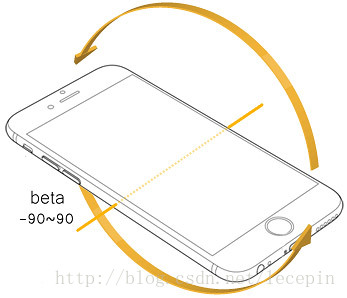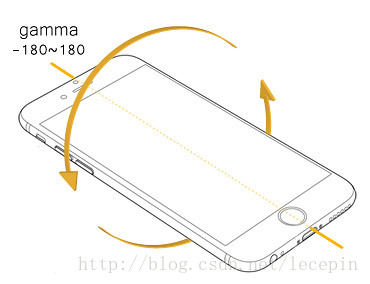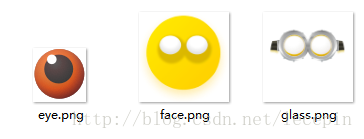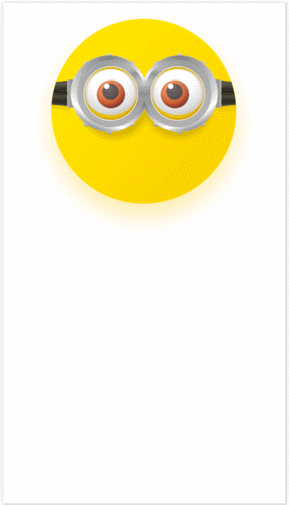When using the ofo Mini yellow car App recently, I found that the previous bottom scan turned into a little yellow person with moving eyes. I think it's quite interesting. Here, I'll use HTML5 to imitate the effect.
ofo eye effect

Effect analysis
It is not difficult to see from the effect that it is realized by using gyroscope events.
Let's take a look at some of the concepts of gyroscope events in HTML5.
Gyroscope event is device orientation. Here we mainly get alpha, beta and gamma in the event.
aplha
When the mobile device is placed horizontally, the rotation angle around the Z axis is 0 to 360 degrees.
beta
When the mobile device is placed horizontally, the angle of rotation around the X axis is - 180 degrees to 180 degrees.
gamma
When the mobile device is placed horizontally, the rotation angle around the Y axis is - 90 ° to 90 °.

Here, we only need beta and gamma.
Decompress apk to get the eye material:
code implementation
<!DOCTYPE html>
<html lang="en">
<head>
<meta charset="UTF-8">
<meta name="viewport" content="width=device-width, initial-scale=1.0, maximum-scale=1.0, user-scalable=no">
<title>Document</title>
<style>
#box{
position: relative;
width: 300px;
margin: 0 auto;
}
#face{
background-image: url(images/face.png);
background-size: cover;
width: 300px;
height: 300px;
position: absolute;
}
#eyeLeft{
background-image: url(images/eye.png);
background-size: cover;
width: 40px;
height: 40px;
position: absolute;
top: 90px;
left: 100px;
}
#eyeRight{
background-image: url(images/eye.png);
background-size: cover;
width: 40px;
height: 40px;
position: absolute;
top: 90px;
left: 190px;
}
#glass{
background-image: url(images/glass.png);
background-size: cover;
width: 300px;
height: 300px;
position: absolute;
}
</style>
</head>
<body>
<div id="box">
<div id="face"></div>
<div id="eyeLeft"></div>
<div id="eyeRight"></div>
<div id="glass"></div>
<div id="log"></div>
</div>
<script>
'use strict';
/*
* author: Wang Leping
* blog: http://blog.csdn.net/lecepin
* date:2017.7.17
*/
var eyeLeftPosition = {
start: [70, 78],
end: [100, 110]
};
var eyeRightPosition = {
start: [150, 78],
end: [190, 110]
};
var eyeLeftCenterPosition = {
x: (eyeLeftPosition.end[0] - eyeLeftPosition.start[0]) / 2 + eyeLeftPosition.start[0],
y: (eyeLeftPosition.end[1] - eyeLeftPosition.start[1]) / 2 + eyeLeftPosition.start[1]
};
var eyeRightCenterPosition = {
x: (eyeRightPosition.end[0] - eyeRightPosition.start[0]) / 2 + eyeRightPosition.start[0],
y: (eyeRightPosition.end[1] - eyeRightPosition.start[1]) / 2 + eyeRightPosition.start[1]
};
var r = 20;
var eyeLeft = document.querySelector('#eyeLeft');
var eyeRight = document.querySelector('#eyeRight');
if (window.DeviceOrientationEvent) {
window.addEventListener('deviceorientation', function (event) {
let {alpha, beta, gamma} = event;
eyeLeft.style.left = eyeLeftCenterPosition.x + gamma / 90 * r + 'px';
eyeRight.style.left = eyeRightCenterPosition.x + gamma / 90 * r + 'px';
eyeLeft.style.top = eyeRight.style.top
= eyeLeftCenterPosition.y + beta / 180 * r + 'px';
eyeRight.style.transform = eyeLeft.style.transform
= eyeRight.style.WebkitTransform
= eyeLeft.style.WebkitTransform
= 'rotate(' + beta + 'deg)';
}, false);
} else {
document.querySelector('body').innerHTML = 'Browser does not support DeviceOrientationEvent';
}
</script>
</body>
</html>Final effect


Blog name: Wang Leping blog
CSDN blog address: http://blog.csdn.net/lecepin